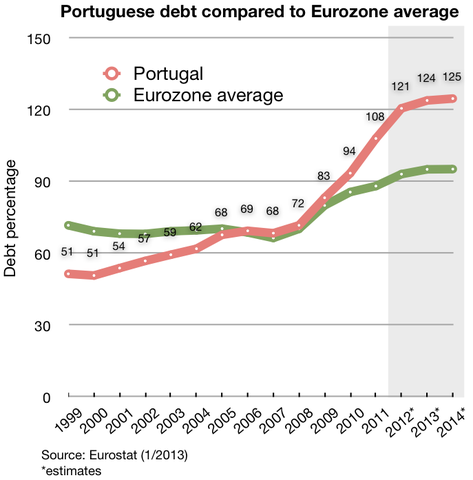 |
This is a file from the Wikimedia Commons. Information from its description page there is shown below.
Commons is a freely licensed media file repository. You can help.
|
Summary
| DescriptionPortuguese debt and EU average.png |
English: Portuguese debt history since 1999. 1999-2011: Eurostat data: http://epp.eurostat.ec.europa.eu/portal/page/portal/government_finance_statistics/data/main_tables (see "General government gross debt")
(see also: epp.eurostat.ec.europa.eu/cache/ITY_PUBLIC/2-23042012-AP/DE/2-23042012-AP-DE.PDF)
2000-2014: Eurostat data: http://ec.europa.eu/economy_finance/db_indicators/gen_gov_data/documents/2012/autumn2012_country_en.pdf (latest update: October 2012)
Once Ernst & Young updates their forecasts, then we could use their data as well: 2015-2016 estimates from Ernst & Young using data from Oxford Economics http://ey-charts.living-digital.com/view-chart?key=19 ; see also: http://www.ey.com/GL/en/Issues/Business-environment/EUROZONE-COUNTRY (latest update: June 2012) |
| Date |
24 October 2012 |
| Source |
Own work |
| Author |
Spitzl |
Licensing
I, the copyright holder of this work, hereby publish it under the following licenses:
 |
Permission is granted to copy, distribute and/or modify this document under the terms of the GNU Free Documentation License, Version 1.2 or any later version published by the Free Software Foundation; with no Invariant Sections, no Front-Cover Texts, and no Back-Cover Texts. A copy of the license is included in the section entitled GNU Free Documentation License. http://www.gnu.org/copyleft/fdl.htmlGFDLGNU Free Documentation Licensetruetrue
|
You may select the license of your choice.
|
File usage
The following pages on Schools Wikipedia link to this image (list may be incomplete):
This file contains additional information, probably added from the digital camera or scanner used to create or digitize it. If the file has been modified from its original state, some details may not fully reflect the modified file.
SOS Childrens Villages aims to make Wikipedia suitable for young learners. More than 2 million people benefit from the global charity work of SOS Children's Villages, and our work in 133 countries around the world is vital to ensuring a better future for vulnerable children. Sponsoring a child is the coolest way to help.



